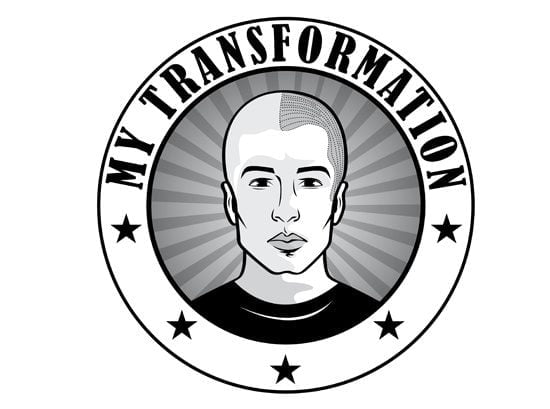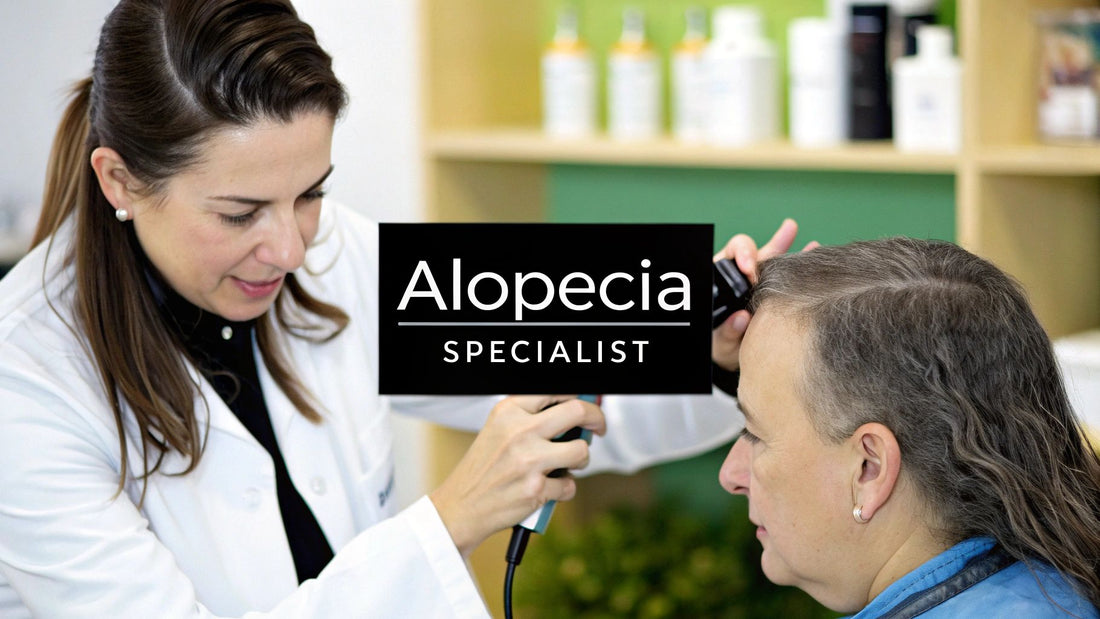
Finding a Hair Specialist for Alopecia in Australia
Share
When you first notice hair loss, figuring out who to see can feel like the biggest hurdle. Getting it right from the start is crucial, as the right hair specialist for alopecia will set you on the quickest path to an accurate diagnosis and a treatment plan that actually works. Let’s break down the key professionals you might meet on this journey.
Who to See First for Alopecia
Facing hair loss is a personal and often stressful experience. Think of choosing a specialist as picking the right guide for a very specific, and sometimes tricky, expedition. In Australia, this journey will almost always lead you to one of two experts: a dermatologist or a trichologist. Knowing the difference between them is the first step to making a smart decision for your health.
A dermatologist is a medical doctor who has specialised in diagnosing and treating conditions of the skin, hair, and nails. They are essentially the ‘medical detectives’ for hair-related issues. Since many types of alopecia are tied to things like autoimmune diseases, hormonal shifts, or other underlying health problems, a dermatologist has the tools to investigate these root causes. They can order blood tests, perform scalp biopsies for a definitive diagnosis, and, importantly, prescribe regulated medications.
A trichologist, on the other hand, is a para-medical hair and scalp specialist. While not medical doctors, certified trichologists have completed intensive training purely focused on the science of hair health. Think of them as ‘scalp health coaches’. They take a more holistic view, digging into how your lifestyle, nutrition, and even your daily hair care routine might be contributing to hair loss.
Dermatologist vs Trichologist Who to See First for Alopecia
Use this quick comparison to decide which specialist is the right starting point for your alopecia journey.
| Specialist Type | Primary Focus | Qualifications | Best For |
|---|---|---|---|
| Dermatologist | Medical diagnosis and treatment of hair, skin, and nail conditions. | Medical Doctor (MD) with specialisation in dermatology. | Suspected medical causes, severe inflammation or scarring, access to prescription medications. |
| Trichologist | Holistic hair and scalp health, including lifestyle and environmental factors. | Certified practitioner (e.g., IAT). Not a medical doctor. | Detailed scalp analysis, hair care advice, and non-medical management strategies. |
So, who should you book in with first?
If you suspect an underlying medical condition is at play, or if you’re seeing signs of severe scalp inflammation, pain, or scarring, a dermatologist is your best bet. Keep in mind that to see a dermatologist in Australia and be eligible for a Medicare rebate, you'll generally need a referral from your GP.
A trichologist is a fantastic choice if you want a deep-dive analysis of your scalp and hair health. They provide expert guidance on nutrition, hair care products, and non-medical strategies to support hair growth. You don't need a referral to see a trichologist, but their services aren't covered by Medicare.
Often, the best approach involves seeing both. A trichologist can provide brilliant supportive care that complements the medical treatments your dermatologist prescribes, giving you a truly comprehensive plan.
The image below gives you an idea of how common different types of alopecia are, and just how many people end up seeking specialist help.
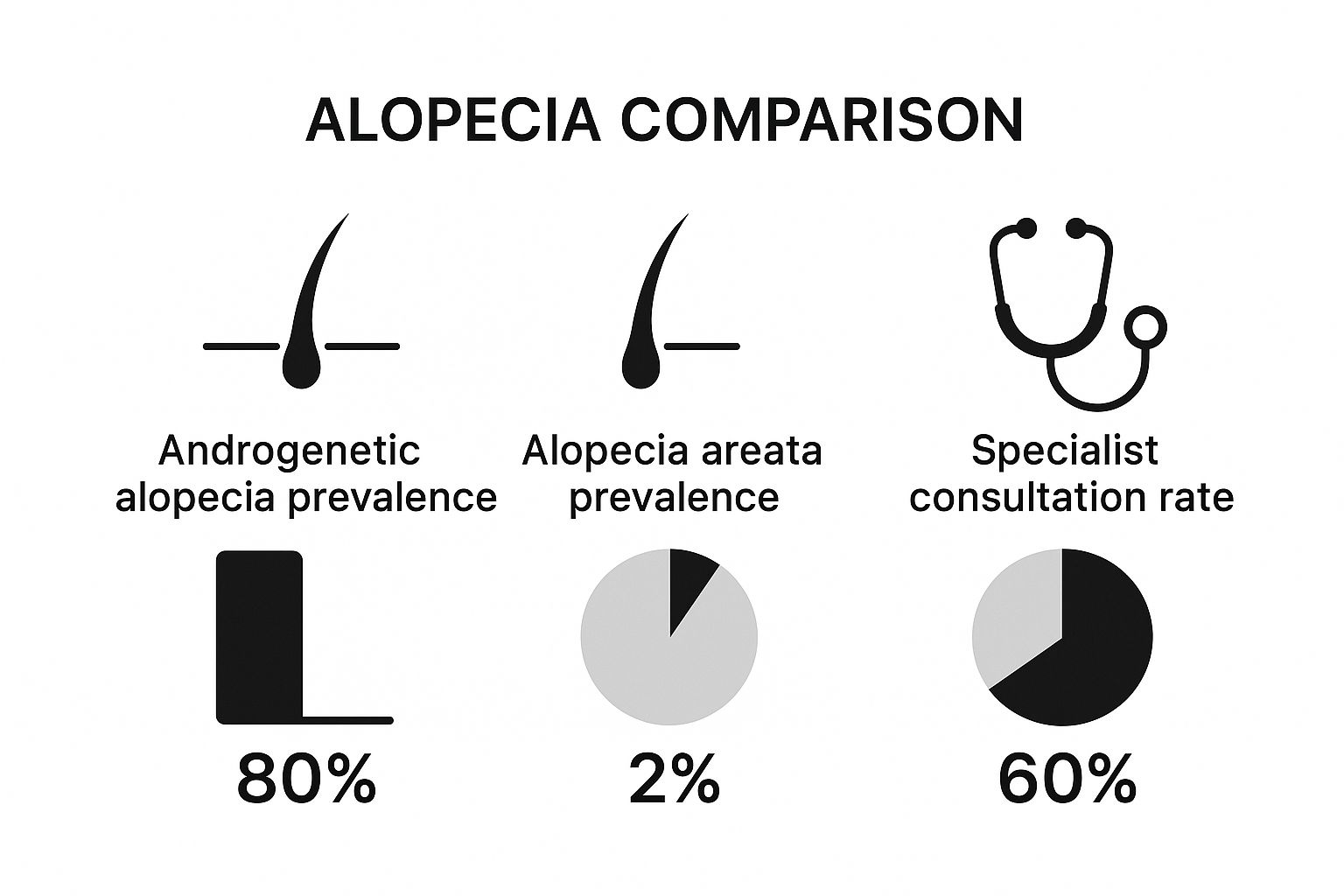
As you can see, androgenetic alopecia (pattern hair loss) is incredibly common. The key takeaway here is that a large number of people—60%—facing hair loss eventually turn to a specialist to get real answers and effective solutions. You're not alone in seeking expert help.
What a Hair Specialist Actually Does for Alopecia
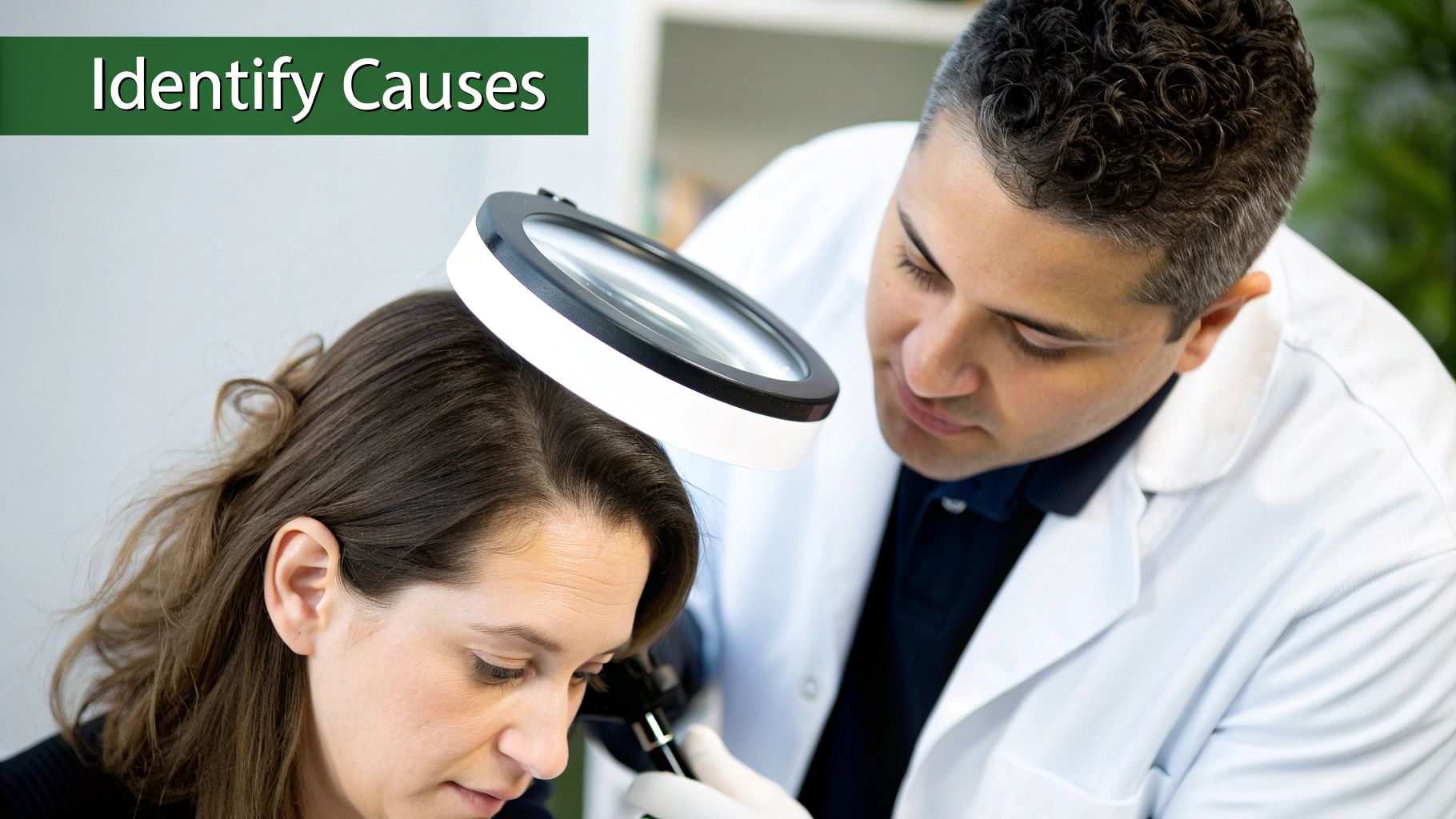
When you finally sit down with a true hair specialist for alopecia, you quickly realise their work is a world away from a quick glance at your thinning spots. Think of them less as a hair stylist and more like a detective. Your scalp is the scene of the crime, and they're there to uncover every last clue.
Their first priority isn't to push a product or a quick-fix solution. It's to build a complete picture of what's really happening under the surface. This investigation always starts with a thorough conversation about you—your medical history, your family's experience with hair loss, your diet, recent stress, and any medications you’re on. Every single detail helps piece the puzzle together.
The Diagnostic Toolkit
Once they have your story, the physical examination begins. This is where a specialist’s experience really comes into play, as they use specialised tools to see what the naked eye can’t.
-
Dermoscopy (or Trichoscopy): This is essentially the specialist’s magnifying glass. A dermatoscope is a powerful, handheld microscope that gives them an incredibly detailed view of your scalp and hair follicles. They're looking for tell-tale signs like "yellow dots" (a common flag for alopecia areata), inflammation, or miniaturised hairs that signal androgenetic alopecia.
-
Hair Pull Test: It sounds simple, but this test is quite revealing. By gently tugging on a small bunch of about 50-60 hairs, the specialist can see how many come loose. This helps them understand if you're in an active shedding phase, which is common in conditions like telogen effluvium.
-
Scalp Biopsy: If the cause is still a mystery, a scalp biopsy might be the next step. It sounds more intimidating than it is—a tiny skin sample is taken from your scalp for lab analysis. This is often the gold standard for diagnosing scarring alopecias, where hair follicles have been replaced by scar tissue.
"A precise diagnosis is the foundation of any effective treatment. Without knowing the exact type and cause of alopecia, any treatment is just a guess. The goal is to move from guessing to targeted, evidence-based action."
Putting all the Clues Together
With all the evidence collected—your personal history, the physical exam, and any test results—the specialist can finally make an accurate diagnosis. This is the most crucial step because different types of alopecia demand completely different treatments. What works for one person could be totally ineffective, or even harmful, for another.

This image really drives home just how varied hair loss can be, highlighting why you need an expert eye to tell the difference. Once they've pinpointed the exact type of alopecia you have, they can craft a management plan that’s built just for you.
This plan might involve medical treatments, lifestyle changes, and other supportive therapies. For many people, cosmetic solutions also play a massive role in rebuilding confidence. For instance, many people explore options like scalp micropigmentation for alopecia, which skilfully creates the look of a fuller head of hair.
It’s important to remember that hair loss is more than skin deep. Studies show that people with alopecia in Australia face a significant psychological toll, with 30% to 38% higher rates of new-onset anxiety and depression. A great specialist gets this. They provide care that supports you both medically and emotionally through your entire journey.
Essential Qualifications for Your Alopecia Specialist
https://www.youtube.com/embed/R39-KqbU_no
Choosing the right specialist is probably the single most important decision you'll make on your hair loss journey. It's a crowded space, and not everyone who talks about hair loss has the same level of knowledge. Knowing what to look for is crucial to separating the genuine experts from the rest.
Think about it like hiring a builder for your dream home. You wouldn't just take someone's word for it; you’d want to see their licence, check their past work, and make sure they have the right experience for your specific project. It’s the exact same principle when you're looking for a hair specialist for alopecia. In Australia, certain credentials act as a baseline for trust and competence, letting you know you're in safe hands.
A dermatologist, for example, absolutely must be registered with the Australian Health Practitioner Regulation Agency (AHPRA). This is non-negotiable, as it confirms they are a qualified medical doctor who has undergone years of rigorous specialist training. On top of that, look for a Fellowship with the Australasian College of Dermatologists (FACD), which signals they've reached a very high standard of practice.
If you’re seeing a trichologist, check for their certification from a respected body like the International Association of Trichologists (IAT). This organisation, which actually started here in Australia, ensures its practitioners have completed specific, in-depth training all about the science of the hair and scalp.
Beyond the Basic Credentials
While formal qualifications are your starting point, they're not the whole story. True expertise comes from years of hands-on experience and a relentless focus on the field. A fantastic general dermatologist might be a miracle worker for acne or eczema but may only see a handful of alopecia cases each year.
You deserve someone who lives and breathes hair loss.
To find that dedicated expert, you need to dig a little deeper. Here are a few things to look for:
- A Specialised Focus: Don't be afraid to ask them directly: "What percentage of your work is dedicated to hair and scalp conditions?" A true specialist will often have a practice that is almost entirely focused on this area.
- Experience with Your Condition: Get specific. Ask about their experience treating your particular type of alopecia, whether it's the more common alopecia areata and androgenetic alopecia, or a rarer form of scarring alopecia.
- Commitment to Learning: The best specialists never stop learning. Ask them about recent conferences they’ve attended or what new research they’re excited about. This shows they’re passionate and up-to-date.
A genuinely qualified professional will welcome these questions. Their confidence comes from a deep well of knowledge and a track record of helping patients navigate this complex condition.
Key Questions to Ask a Potential Specialist
When you finally get to your consultation, having a few smart questions ready can tell you everything you need to know. This isn't about grilling them; it’s a simple conversation to make sure you're both on the same page and that they’re the right partner for your health.
Consider asking things like:
- What does your diagnostic process look like? A real expert will outline a thorough approach, including a detailed personal history, a close scalp examination (often with a tool called a trichoscope), and potentially blood tests or even a small biopsy.
- What different treatment options do you offer? A great specialist will talk you through multiple pathways, from medical therapies to supportive care, instead of trying to sell you on a single solution.
- How will we track my progress? You should hear about a clear plan involving follow-up appointments, clinical photography to document changes, and defined goals for what success looks like.
- What are the realistic outcomes for someone with my condition? An ethical and experienced specialist will always give you an honest answer, setting clear and realistic expectations about timelines and results.
Putting in this effort up front ensures you find a professional who not only has the right piece of paper on the wall but also has the dedicated focus you need to manage your alopecia effectively. Of course, other solutions like cosmetic tattooing also require careful research. To understand the investment involved in those options, exploring details on how much scalp micropigmentation costs can give you a more complete picture.
Understanding Alopecia Treatment Options in Australia
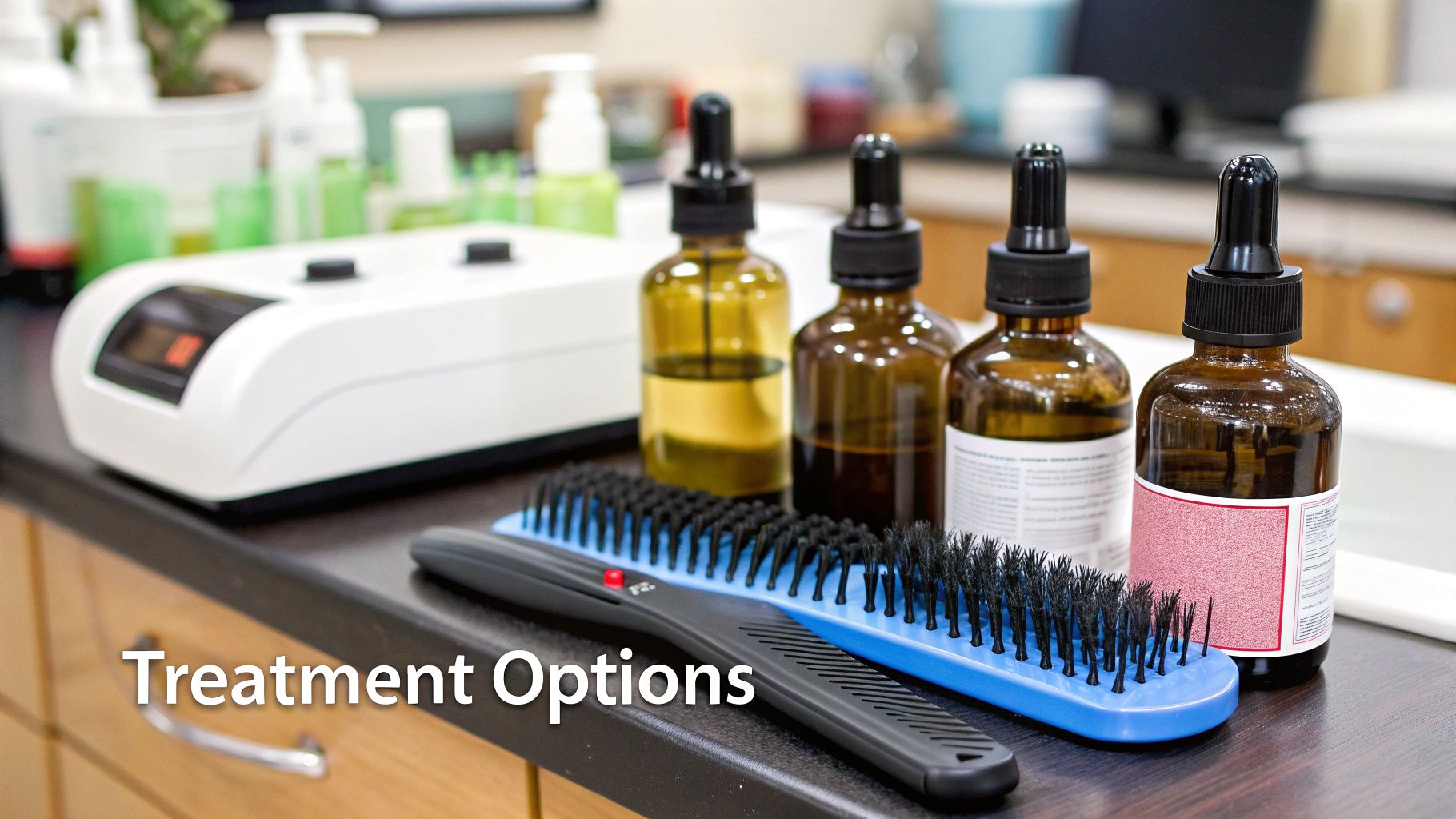
Getting a specific alopecia diagnosis is a huge step. It takes you from the confusing stage of "what's happening to my hair?" to the more empowering question of "what can I do about it?". Thankfully, the range of treatments available for hair loss in Australia has never been better. A good hair specialist for alopecia won’t just hand you a pamphlet; they'll be your guide through it all.
The golden rule in modern hair loss treatment is personalisation. There's no one-size-fits-all solution because every type of alopecia has a different root cause. What works brilliantly for genetic hair thinning might do nothing for an autoimmune condition like alopecia areata. Your specialist’s job is to match the right treatment to your exact diagnosis, its severity, and your overall health.
This targeted strategy means you won't waste time, money, or hope on therapies that simply aren't right for you. It's all about moving forward with a clear, evidence-based plan that’s built just for you.
Core Medical Treatment Categories
When you chat with your specialist, the options will likely fall into a few main groups. Getting your head around these categories helps you take an active role in the conversation about your treatment plan.
1. Topical Solutions
These are treatments applied directly where they're needed—on the scalp. They are often the first port of call, particularly for non-scarring types of alopecia.
- Minoxidil: Easily the most recognised topical treatment out there. Minoxidil helps by keeping your hair in its growth phase (the anagen phase) for longer. It's available over-the-counter in Australia and is a go-to for androgenetic alopecia. Your specialist can advise on the right strength, like a 5% topical solution, to get the best results.
- Topical Corticosteroids: For alopecia areata, which is caused by inflammation, these creams and lotions can help settle down the immune response right at the scalp. This creates a much friendlier environment for hair to start regrowing.
2. Oral Medications
When topical treatments aren't quite cutting it or aren't suitable, your specialist might prescribe oral medications that work from the inside out.
- Finasteride and Dutasteride: These are the main players for treating male pattern baldness. They work by blocking the enzyme that turns testosterone into dihydrotestosterone (DHT)—the hormone that shrinks hair follicles.
- Oral Minoxidil: A low-dose pill version of minoxidil is becoming a popular choice for conditions like androgenetic alopecia and chronic telogen effluvium. It's a great alternative for anyone who finds applying the topical solution a hassle.
- Anti-Inflammatory and Immunosuppressants: For more severe inflammatory or autoimmune types of alopecia, medications such as hydroxychloroquine or methotrexate might be used to get the underlying condition under control.
A specialist tailors your treatment not just to your diagnosis, but to your life. They consider factors like cost, convenience, and potential side effects to create a plan that is both effective and sustainable for you.
Advanced and Emerging Therapies
The world of hair loss treatment is always evolving, thanks to new research and a real need for better solutions. You can see this reflected in the market itself; the Australia Alopecia Treatment Market was valued at over 100 billion USD and is projected to surge past 180 billion USD by 2032. This incredible growth highlights the demand for expert care and new therapies. You can dig deeper into these trends in this Australian alopecia treatment market research.
Some of the more advanced options your specialist might bring up include:
- Biologic Therapies (JAK Inhibitors): These are a genuine breakthrough for severe alopecia areata. These targeted drugs work by interrupting the specific immune signals that tell the body to attack hair follicles, making them a powerful option for widespread hair loss.
- Steroid Injections: For smaller, stubborn patches of alopecia areata, a dermatologist can inject corticosteroids directly into the affected spots. This delivers a concentrated dose of anti-inflammatory medicine right where it's needed most.
- Cosmetic and Supportive Solutions: Medical treatments often work best alongside other strategies that boost appearance and confidence. You might want to check out our guide on what is scalp micropigmentation, a clever technique that creates the look of thicker hair.
Your journey with alopecia is a partnership between you and your hair specialist. By understanding the tools and treatments available, you can be an active participant in building a plan that gives you the best possible chance of success and helps you feel back in control.
Why a Holistic and Personalised Approach Is Crucial
Alopecia is never just a physical condition. Its effects run much deeper, influencing how you see yourself and how you move through the world. The best hair specialist for alopecia understands this profoundly and knows that to treat hair loss effectively, you have to look at the whole person, not just the scalp.
That’s why a holistic and personalised approach isn't just a nice-to-have; it's absolutely essential for successful management and your overall wellbeing. Think of it like this: if your car's engine warning light comes on, a good mechanic doesn't just switch off the light. They get under the bonnet, check the engine, and ask you how the car has been running to find the root cause. In the same way, a top-tier specialist connects the physical symptoms with the emotional and psychological stress that so often comes with hair loss.
More Than Just Hair
The link between losing your hair and your mental wellbeing isn't just a feeling; it's backed by clear evidence. When you're dealing with alopecia, feelings of anxiety, frustration, and a real knock to your confidence are incredibly common. A specialist who only focuses on prescribing a cream or pill without acknowledging this emotional toll is missing half the picture.
True care involves creating a safe space where you feel heard and understood. It means the specialist really listens to your fears and frustrations, validating what you're going through. This kind of empathetic connection builds trust and makes the entire treatment journey feel less isolating and more like a partnership.
"A holistic approach treats the patient, not just the alopecia. It integrates medical science with genuine human empathy, ensuring the treatment plan supports both physical regrowth and emotional recovery."
This approach is particularly vital given the real-world impact of the condition. A significant Australian patient study of 337 people with alopecia areata found a strong link between the amount of hair loss and a person's quality of life. The research showed that more severe hair loss directly correlated with higher levels of anxiety and depression, and even reduced work productivity. You can explore the findings of this impactful study on alopecia and quality of life.
This data is a powerful reminder of why a specialist must manage both the physical symptoms and the profound psychosocial effects of alopecia.
Creating a Truly Personalised Plan
A holistic mindset naturally leads to a personalised treatment strategy. Since no two people experience alopecia in exactly the same way, no two treatment plans should be identical. Your specialist will consider a wide range of factors that are unique to you.
These factors often include:
- Your Specific Diagnosis: Nailing down the exact type of alopecia you have is the first and most critical step.
- Your Lifestyle: Things like your stress levels, diet, and daily routine can all play a part and need to be factored into your management plan.
- Your Personal Goals: What does success look like for you? Is it slowing the shedding, achieving regrowth, or simply feeling more confident with a cosmetic solution?
- Your Emotional State: Acknowledging your mental wellbeing and offering support or resources is a key part of any comprehensive plan.
By weaving these elements together, your specialist moves beyond a generic, one-size-fits-all script. They create a responsive, flexible plan that evolves with you. This might mean combining medical treatments with supportive therapies and cosmetic options. For instance, while a medication works on regrowth, a procedure with proper scalp micropigmentation aftercare can provide an immediate and significant confidence boost.
Ultimately, this personalised and holistic method ensures you feel seen, supported, and empowered every step of the way. It transforms the experience from a lonely battle against hair loss into a collaborative journey toward renewed wellbeing.
How to Prepare for Your First Consultation

Walking into your first appointment with a hair specialist for alopecia can feel a bit overwhelming, but a little bit of prep work goes a long way. When you're organised, you can have a real, productive conversation with your specialist. It means they get the whole story, and you walk out feeling clear and confident about what's next.
Think of it like a fact-finding mission. You bring the personal history, and they bring the expert analysis. To make that first meeting truly count, it helps to gather some key information beforehand. Your specialist needs to understand not just your hair, but your overall health and lifestyle, too. Turning up with these details ready helps them connect the dots much faster, moving you closer to the right diagnosis and an effective plan.
Your Pre-Appointment Checklist
Before you head to your consultation, spend a little time putting together a brief history of your hair loss journey. It doesn't need to be a formal report, but having these details ready is incredibly helpful.
- Your Medical History: Make a note of any major health conditions, past or present. This is everything from thyroid problems and autoimmune diseases to recent illnesses or surgeries.
- A Simple Hair Loss Timeline: Try to remember when you first noticed the thinning or shedding. Did it happen suddenly, or has it been a slow creep? Does it seem to come and go in phases? These patterns are crucial clues.
- Current Medications and Supplements: List everything you take regularly. This means prescription meds, over-the-counter products, vitamins, and even herbal supplements. Some of these can directly influence hair health.
- Family History: Does hair loss run in your family? Knowing if your parents, grandparents, or siblings have dealt with alopecia can be a big piece of the diagnostic puzzle.
Being prepared for your first consultation is one of the most powerful things you can do. It allows your specialist to focus on a precise diagnosis rather than spending the whole appointment just gathering basic information.
Key Questions to Ask Your Specialist
This consultation is a two-way street. It's your chance to interview the expert and get a feel for their approach. Having a few questions ready shows you're an active partner in your own care and helps you make sure they're the right fit for you.
- What is your diagnostic process? A good specialist will outline a clear process. This usually involves a deep dive into your history, a close look at your scalp (often with a special magnifying tool called a dermatoscope), and sometimes blood tests or a small biopsy.
- Based on what you see today, what are the possible causes? This question gets the ball rolling on potential diagnoses and gives you a window into their initial thinking.
- What are the next steps after today? You should leave knowing exactly what comes next. Will there be more tests? A follow-up appointment to discuss results? Or are you ready to start a treatment plan?
- How do you typically monitor patient progress? You want to hear about a structured approach. This should include things like regular follow-up visits, taking clinical photos to track changes, and setting clear goals for what success looks like. It shows your treatment will be actively managed, not just a "set and forget" plan.
Common Questions About Aloopingcia Specialists
Deciding to see a professional is a huge step, but it often brings up a whole new set of practical questions. You might be wondering about referrals, costs, and how long it all takes. Getting your head around how the Australian healthcare system handles hair loss will help you map out your next steps with confidence.
Let's clear up some of that uncertainty. Answering these common questions upfront means you can focus on what really matters: getting a proper diagnosis and finding a treatment plan that works for you with a qualified hair specialist for alopecia.
Do I Need a GP Referral in Australia?
This really depends on who you want to see.
If you’re aiming to see a dermatologist (a medical skin and hair doctor), then yes, you absolutely need a referral from your GP to be eligible for a Medicare rebate. Your GP is the perfect place to start anyway. They can perform an initial assessment and order blood tests to check for common culprits like thyroid problems or nutritional deficiencies.
On the other hand, if you're seeing a trichologist (a non-medical hair and scalp expert), you don't need a referral at all. You can book an appointment directly with them. Just keep in mind that since they aren't medical doctors, their services aren't covered by Medicare.
How Much Does a Consultation Cost?
Consultation costs can vary quite a bit, so it pays to be prepared.
In Australia, an initial chat with a dermatologist typically ranges from $200 to over $400. With that GP referral in hand, you’ll be able to claim a portion of this fee back from Medicare.
A trichologist's fees usually fall into a similar bracket. The key difference is that there’s no Medicare rebate. It’s always a smart move to ask about the exact consultation fees when you book your appointment to avoid any surprises down the track. Any treatments your specialist recommends will be a separate cost on top of this.
How Long Until I See Treatment Results?
Patience is probably the hardest, but most important, part of any hair loss treatment. Results are never one-size-fits-all; they depend on your specific type of alopecia, the treatment itself, and how your own body responds. Some people might spot the first signs of new growth within 3 to 6 months, while for others, it can be a much slower journey.
Your specialist will give you a realistic timeline based on your diagnosis and treatment plan. It also helps to understand how other factors play a role, like the connection between stress-related hair loss and shedding, as managing these underlying issues is crucial for success. Your progress will be closely tracked during follow-up appointments.
At My Transformation, we understand the emotional and physical challenges of hair loss. If you're looking for a solution that delivers immediate, confidence-boosting results, explore how our expert Scalp Micropigmentation services can help. Take control of your story today by visiting https://www.mytransformation.com.au.
